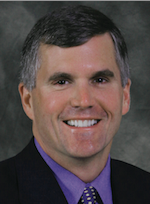
As recently as 2004, New York Life sold only $200 million of income annuities annually. But now the trickle of sales is turning into a steady stream. In 2010, sales totaled $1.9 billion, up 9% from the year before. In the first quarter of this year, the figure jumped 45% from the period a year ago. The gains are substantial in a total market of $7.9 billion.
The growth of income annuities is just beginning, predict Chris Blunt, New York Life’s executive vice president of Retirement Income Security. “In the next ten years, this will become a $100 billion market,” he said in a recent interview.
[In the third quarter of 2011, New York Life intends to introduce a product that could make that market even bigger: a deferred income annuity designed to let people in their 50s or younger buy future guaranteed income at a discount.]
As more baby boomers wake up to the need for safe sources of retirement income, Blunt (at left) expects this type of annuity to be a compelling product.  Retirees can use income annuities to guarantee themselves enough income to maintain a desired lifestyle for life. The problem so far is that insurance agents and financial advisors have been reluctant to sell them. Commissions for selling income annuities (usually about 3.5% of premium) are low compared to variable annuities and indexed annuities. And clients have historically balked at the product’s inherently low liquidity.
Retirees can use income annuities to guarantee themselves enough income to maintain a desired lifestyle for life. The problem so far is that insurance agents and financial advisors have been reluctant to sell them. Commissions for selling income annuities (usually about 3.5% of premium) are low compared to variable annuities and indexed annuities. And clients have historically balked at the product’s inherently low liquidity.
If you’re relatively new to income annuities, here’s how they work. In a typical contract, a 70-year-old man (or couple) might give the insurance company $100,000 and get a fixed annual income for life.
The longer the client lives, the greater the “effective return” on the initial “investment.” (Income annuities are insurance, not investments, and a widespread misunderstanding of the difference is an obstacle to greater acceptance.) But if the client dies in the first year or two—and if the client hasn’t taken the precaution of stipulating a minimum payout period or of setting aside a legacy—heirs may feel cheated because they have no access to the income or principal.
New York Life, the world’s largest mutual insurance company with some $16 billion in reserves, has to some degree overcome resistance to income annuities with a marketing campaign that emphasizes the value of lifetime income. To explain the value of income annuities, agents contrast them with portfolios of mutual funds, Blunt said.
Blunt cites the example of a 65-year-old man with a $500,000 portfolio that has 42% of assets in equities and 58% in bonds. Each year the retiree withdraws a total that is equal to 4.5% of the initial value of the portfolio. Based on market history, there is a 25% chance that the portfolio will be exhausted by the time the retiree reaches 92. 
He compares this with a portfolio that has 43% of assets in equity, 17% in bonds, and 40% in income annuities. Thanks to the lifetime guarantee on the annuity income, there’s little chance that any combination of planned withdrawals or market downturns will exhaust the second portfolio before the investor dies, so the investor is more likely to have money left for heirs than if he did not have an annuity. Blunt’s example also punctures one of the myths about income annuities: that you have to devote all your savings to it.
Annuities can deliver higher income because their payment stream includes interest, principal, and—most importantly—the “survivorship benefit.” In a $100,000 portfolio of mutual funds, an investor might safely withdraw $4,500 in the first year. But if the investor puts $100,000 into a life annuity, the annual payout would be about $8,000.
The income is high because of that survivorship benefit. When contract owners die, their remaining principal goes to the insurance company, which uses it to pay other contract owners in the same age-pool. (Of course, actuaries calculate the payouts in advance, before any of the contract owners has died, and there’s a survivorship factored into every payment.)
To alleviate client concerns about losing access to their money, New York Life has been offering liquidity features. A cash-refund option, for instance, promises the client and the heirs a return of at least the original principal. Say a client pays $100,000, receives $8,000 income the first year, and then dies. Heirs would get a check for $92,000.
But the cash refund option is not cheap, because you’re giving up the survivorship credit. In a recent quote, a 70-year-old female who took a plain-vanilla contract got $7,760 a year. With the cash refund feature, the contract only provided $7,071.
Blunt says that New York Life gained a leadership position in income annuities because the company has fastidiously fine-tuned the product. “We have spent five years trying to figure out how to market and position these products,” he says. “For most of our competitors, this is not a core business.”
For insurance companies, income annuities are not highly profitable because they require substantial capital, says Blunt. As a result, they may not be ideal products for publicly-held insurers, which must maximize profits. But income annuities can be attractive for mutual companies like New York Life, which seeks to deliver steadily growing profits. Unlike many publicly held insurance companies, New York Life came through the financial crisis in good shape. Today’s low interest rates aren’t necessarily good news for sales, but income annuities rates are tied to long-term bond yields rather than short-term yields.
New York Life is unusually well equipped to cope with longevity risk exposure—the danger that life expectancies will surge unexpectedly, perhaps because cancer or other diseases are cured. If that happened, the company would have to pay out far more lifetime income than planned.
But New York Life’s losses would be balanced by gains on the life insurance side. In an era of greater longevity, the company’s life insurance business would pay out less in claims, making the two products complementary. Many competing insurers could not offset the losses because they tend to focus on variable annuities or other businesses that do not benefit from greater longevity.
© 2011 RIJ Publishing LLC. All rights reserved.
This reprint is being provided as a courtesy by New York Life Insurance Company with the permission of Retirement Income Journal. It is for informational purposes only and represents the views and opinions of its author, who is solely responsible for its content. New York Life’s basis for its example is based on the FRC Whitepaper “Income Annuities Improve Portfolio Outcomes in Retirement”. FRC (Financial Research Corporation) is an independent research firm not affiliated with New York Life Insurance Company or any of its subsidiaries. The research for this paper was funded in part by New York Life.
The example cited was based on the following:
The asset allocation was tested rigorously by assuming 25th percentile life expectancy of a 65 year old to age 92 and 10th percentile results to age 96. Withdrawal rates of 4%, 4.5%, and 5% were assumed. The assumed income annuity payout rate, assuming a 3% inflation rider, was 5.1%, which is largely reflective of current payout rates and the current low interest rate environment. Had FRC employed normalized rates across market cycles, the payout would have been closer to 6%, with a 3% inflation rider. The analysis focused on 4% and 4.5% withdrawal rates, based on the past experience shared by financial advisors with FRC in past research. In the 1000 scenarios created by FRC in its Monte Carlo simulations, aggregate index returns and standard deviations were used and not portfolio returns. Indexes results are unmanaged and do not reflect actual product fees, charges and taxes. FRC primarily relied on examples from the Ibbotson ETF asset allocation series for its model portfolios, including both a conservative and moderate portfolio. An aggressive portfolio was not considered, given the logical conservative profile of an average retiree. The FRC simulations applied hypothetical fees and expenses to the returns, including fees of 25bps and a wrap advisory fee of 100 bps. In its simulations, FRC applied federal income tax rates which were assumed to be relatively low given the low-dollar withdrawals assumed in the sales concept. The marginal tax rate or the tax rate applied to the investment income and the rate applied to any additional dollars of income was 15%. The calculated average tax rate of the rate applied to the regular income was 13.8%. The average tax rate is slightly lower than the marginal tax rate since the model assumed a certain level of standard deductions.
The results shown are the median results of a Monte Carlo simulation of 1000 market scenarios. Median results relate to probabilities; they are not indicative of either the past or future performance of any type of securities or client results. In all likelihood an investor’s results will vary from the median and be affected by factors which the study does not address: how investment decisions are implemented in reality; the client’s investment objectives and risk tolerance and suitability for allocating a significant percentage of retirement assets to a less-liquid annuity vehicle; the costs of investing; and the actual tax profile of any client. No assurance can be offered about the future performance and payout trends of any asset class portrayed in the FRC whitepaper. Significant asset classes such as non-US securities were not evaluated in the FRC analysis. In the future, asset classes could come into favor which would alter the results of an analysis such as the FRC whitepaper.
In order to reduce the impact of the last 10 years of fat tail events, FRC used 20-year historical standard deviations for each asset class along with subsequent correlations over that 20-year period. While the standard deviations and correlations over longer historical periods were considered, the most recent 20-year returns and standard deviations represented a more appropriate conservative approach given the heightened volatility in the markets over the last decade. The models accounted for inflation, using 2.5% as an acceptable normalized annual measure. Withdrawal amounts were inflated annually by 2.5%. RMDs, required minimum distributions, were taken into account and assumed to begin at age 70. For any amounts withdrawn over and above the assumed cash needs, the excess cash flow was reinvested into a non-qualified account using the same asset allocation.
Unlike traditional asset classes, annuity payments involve systematically returning the client’s principal to him or her. Annuities may be more favorable to older clients, when mortality credits can impact the payout of the annuity in later years. Access to a client’s money in an annuity can be significantly affected by surrender charges and taxation. Annuities are a long-term retirement-income vehicle, and an insurance company’s financial condition can change over time.
IMPORTANT: The projections or other information regarding the likelihood of various investment outcomes are hypothetical in nature, do not reflect actual investment results, and are not guarantees of future results. Past performance is no guarantee of future results. This example only presents a range of possible outcomes.
New York Life Lifetime Income Annuities are issued by New York Life Insurance and Annuity Corporation (A Delaware Corporation), a wholly owned subsidiary of New York Life Insurance Company, 51 Madison Avenue, New York 10010. Guarantees are backed by the claims-paying ability of the issuer.



